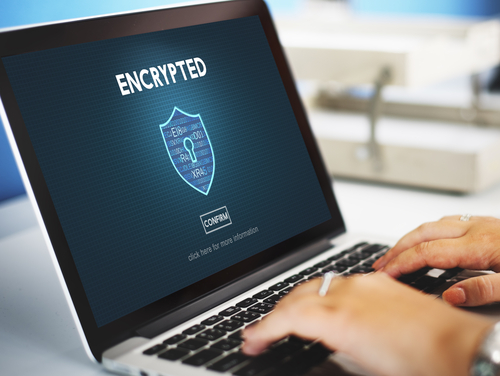Over half of all cloud-based cyberattacks are brute-force attacks. Hackers use this method to gain unauthorized access to user’s accounts by exploiting weak passwords, PINs, and passcodes.
A brute force attack is when a cybercriminal uses trial and error to figure out your password. These attacks can result in identity fraud and the loss of sensitive information. Let’s explore some tips for how to reduce your risk of a brute-force attack.

What Is a Brute Force Attack?
A brute force attack is a method hackers use to crack passwords, encryption keys, and login credentials. These hackers force their way into accounts by guessing your password and username combinations until they get the right login information.
They often use a computer with superpowered software to test a wide range of combinations of usernames and passwords in record time until they find the correct one. This is a very old hacking method, but it is a popular, tried-and-true way for cybercriminals to steal your data.
What Types of Brute Force Attacks Are There?
There are a few different types of brute force attacks that cyber attackers use to steal users’ information. Cybercriminals are constantly refining and adapting their methods to suit the current trends.
Simple Brute Force Attack
Many people use weak passwords. These can be as simple as a sequence of numbers, a birthdate, or an easy-to-guess word. Attackers using a simple brute force attack don’t use sophisticated computer software to figure out password combinations.
They simply do a little digging to find out basic information about an individual that is readily available online, then they try different combinations of simple passwords and usernames to break into the account.
This method is tedious and not as successful as other brute force attacks, but if you have been careless about your username and password information online, this can be an easy way for a hacker to break into your account.
Offline Brute Force Attack
Sometimes cybercriminals can get a hash of your password and take it offline to crack it. A hash is a one-way form of encryption. Your computer saves your password as a hash, which is a mathematical algorithm, to prevent someone from figuring it out.
However, when you try to log into your account, the computer will retrieve this hash and compare it to the password you input. If they match, you’ll be able to access the account. A hacker can take the opportunity when your computer brings up your hash and use a computer to quickly compare passwords until they find a match.
The hacker will record your hash, then take it offline and put it through their super-powered computer. An offline brute force attack is harder to detect than an online one because the hacker will not be subjected to limited login attempt alerts.
They can try password and login combinations until they get it correct. Then, they’ll take this information and use it only once online to unlock the account. Offline brute force attacks can be fast, as well. A strong computer can break an 8-character password in about 3 days.
Online Brute Force Attack
Online brute force attacks are when a hacker tries a large number of username and password combinations against the login portal trying to guess the correct one. The speed of the network and the login interface, however, can make these types of attacks harder to pull off.
A typical password attack does about 3-5 attempts per second. This speed may vary based on the network traffic. So, in some cases, it may take longer to guess the password using an online brute force attack. Also, nowadays, many applications have an alerting protocol that limits login attempts.
Once an account surpasses a certain number of login attempts (usually less than 10), the account locks. Online brute force attempts are more difficult to pull off than offline ones.
Dictionary Attack
This attack method is when a cybercriminal targets one specific person. They take a person’s username (usually found on the dark web or from data breaches) and test passwords against the username.
Hackers run through dictionary words checking and trying them with special characters and numbers as possible combinations. This is a time-consuming type of attack that has a lower chance of success. Yet, if the attacker already has partial information about the user that can help them crack the password more easily, this process is easier and quicker.
Hybrid Brute Force Attack
A hybrid brute force attack is a combination of a dictionary attack and a simple brute force attack. In this instance, the hacker knows the username. They usually gain this information from the dark web or through data breaches. Then, they use both methods to discover the correct password and username combination.
Reverse Brute Force Attack
If a company you do business with has a data breach, it can lead to your sensitive data making it to the dark web. In a reverse brute force attack, a cybercriminal has a known password that they gained, but they need to match it to the correct login credentials.
They do this by using a list of millions of usernames until they find the right one. A computer program makes this process quick and effortless. These hackers may also use the fact that many people use common passwords like “password123” to complete the attack and gain unauthorized access to an account.
Credential Stuffing
If you have a weak password, hackers can use your stolen credentials to try other websites to gain access to other accounts. If your username and password for one account get compromised through a phishing scam or malware, a hacker can use this information to gain access to your other accounts.
Many people reuse the same password and username for several different accounts. Although this may be convenient for you, this can become a vulnerability if a cybercriminal figures out your password and username combination.
Then, the hacker can access your other accounts using this information. This is an easy way for a hacker to steal your identity.
Rainbow Table Attacks
A rainbow table is a table that stores cryptographic hash functions. Attackers can use these tables to reverse the hash functions and guess their passwords. A mathematical algorithm creates these hash values to store your password securely.
However, if a criminal gets a copy of these hashed passwords from a system attack, they can use it to crack passwords. Cybercriminals commonly use this table to crack Windows passwords.
How Can You Prevent a Brute Force Attack?
If you are worried about being subject to a hacker, you may want to take measures for brute force attack prevention. By using these safety procedures, you’ll strengthen your account against these types of attacks.
#1 Create Complex Passwords
According to a study by Heerden and Vorster, most people create passwords that are between 6-10 characters long. This study calculated how long it would take someone to crack a password using a brute force attack based on the number of characters in the password.
Longer passwords are harder to crack. A 12-character password would take a hacker about 80 seconds to crack using brute force attack tools. Many hackers have access to lists of possible passwords for certain companies.
This gives them a strong advantage of selecting the correct password for your username. However, building a strong password that is 12 characters or longer with a combination of numbers and special characters reduces your risk of being a victim of a brute-force attack.
Passwords should not contain common words like “password” “qwerty” or “admin.” Dates and numbers in a sequence are also common passwords that are easy to guess. If you have trouble creating and maintaining passwords, it may be to your advantage to get a password manager.
These programs will keep track of your passwords, alert you if the password is compromised, and some will even generate unique passwords for you. However, if you are a company, passwords are not the only target for brute force attacks, directories of usernames and other personal data are also at risk.
So, it is a good idea to make sure you protect more than just your password.
#2 Use CAPTCHA
If you have a website that you want to protect from a brute force attack, CAPTCHAS (Completely Automated Public Turing test to tell Computers and Humans Apart) can help prevent bots and automated tools from accessing your web pages.
These generated tasks are easy for people to complete but difficult for automatic computer programs to perform. CAPTCHAs are relatively easy to install on WordPress and have a success rate for improving your web page’s cybersecurity.

#3 Enable Two-Factor Authentication
Multi-factor authentication is a great way to protect your account against brute-force attacks. Even if a hacker can guess your password and username, if they try to log into your account, they will need to complete the second step.
This is usually a one-time passcode sent to a device that is on your person. If you get a notification that there has been an attempt to access your account that you did not make, you can stop the hacker in their tracks by changing your password.
#4 Limit Login Attempts
If you have an application or are a service provider, you may want to limit the number of times your clients can have a failed login attempt. After a certain number of login attempts, you can enable a denial-of-service, which can lock out IP addresses or lock down the account.
The actual account holder will have to contact customer support to reset the password providing more complex identifiers. This can help keep your user accounts safe. If a user’s account has 10 or more failed login attempts within a few days up to a week, this can be an indication of a brute-force attack.
Limiting login attempts makes online brute force attacks more difficult for hackers, but it doesn’t stop all brute force attacks, since some attacks work by finding out the combination before attempting to log in.
#5 Install a Firewall
To protect your data privacy from unauthorized access, installing a firewall can protect you against brute-force attacks. Firewalls will notify you if someone has attempted to access your web applications. These programs also help prevent hackers from installing malware on your device that can run and gather personal data the criminal can use for password cracking.
Malware can steal personal data, track your activity, and compromise your passwords and usernames. It is important to protect yourself against malicious software by avoiding links sent by unusual senders. Malware can also install viruses onto your computer, slowing down productivity and making it easy for hackers to gain access to your personal data.
Installing and keeping a firewall up-to-date on your computer should help reduce your risk of having malware installed on your devices.
Sekur Can Protect You from Attacks
If you are looking for a way to protect yourself against a brute-force attack, Sekur can help. We provide Swiss-hosted, private email, VPN, and instant messaging. We are free from big tech companies, so you can feel confident that your data is secure.
We don’t data mine and our servers are located in Switzerland, which has some of the best privacy laws in the world. With our VPN, you can protect your IP address in our 2048-bit encryption tunnel. You can also send encrypted emails in the safety of Sekur’s proprietary HeliX encrypted tunnel.
Communicating with instant messaging is easy and private with our self-destructing, encrypted chats. Regain your privacy and try Sekur today.
Conclusion
Brute force attacks are a common method for hackers to access accounts.
They use a variety of methods to achieve this trial-and-error attack, but there are ways you can prevent the loss of personal data. Using stronger passwords, enabling CAPTCHA on web pages, utilizing multi-factor authentication, and installing firewalls on your devices can prevent brute force attacks.
Pair these best practices with an encrypted VPN server to beef up your cybersecurity for either your business or personal accounts.

